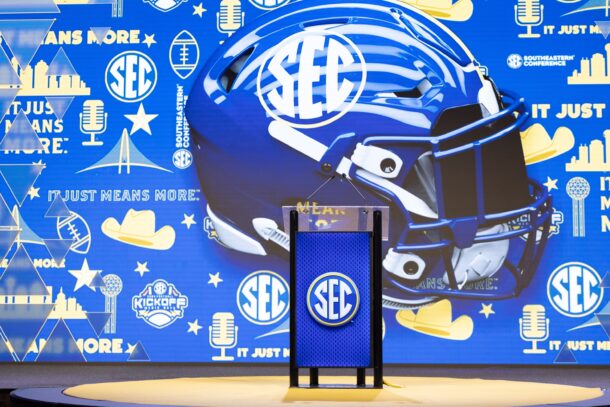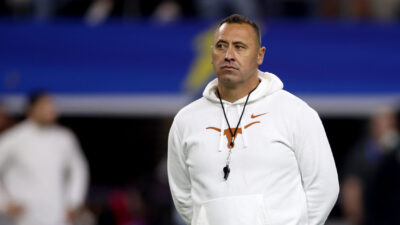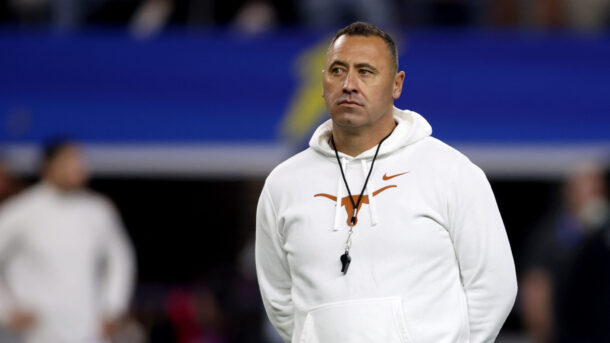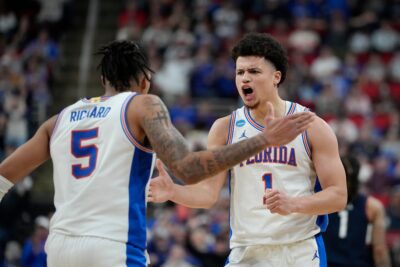Ad Disclosure

To be sacred is to be treasured. In life, and certainly on SEC football fields. The most passionate college football fans in the country have the programs they live and die with, and within those boundaries come the special ones who they cling to and recall and watch highlights of on YouTube whenever they get the itch.
At each school, the treasured ones walk on water, and they walk forever. Their jersey numbers? Well, they come along for that endless ride. The jerseys are a part of the memory. Each SEC legend wore a number, and it’s the stamp that’s attached to them, in some ring of honor or school hall of fame or just in fans’ euphoric memory banks.
Name a Tennessee hero to a Tennessee fan and he or she will likely call out their number before you can finish asking them the question. Same deal at the other 13 schools. It’s a prideful thing. It’s a proud thing. It’s a wonderful thing.
So with a smile and a wink for the good, old days during which these legends starred or inspired and with the knowledge that their spirits will never die, we give you 10 jersey numbers in the SEC that are sacred. These are hardly the only 10. But they’re our 10 — and we didn’t include anybody who made last year’s version. So no 34s for Herschel and Bo, or 10, 16 or 18 for the Mannings. They’re all here.
No. 15, Florida: Tim Tebow
This is new-school sacred, being that the Gainesville icon left college less than a decade ago with a Heisman and two national titles. But this is also a guy whose famous speech after a home loss to Ole Miss in 2008 was immortalized on a plaque outside Ben Hill Griffin Stadium, the promise that the Gators would respond with a vengeance the rest of that season.
They did. They won the national title, and Tebow’s place in college football history and UF lore was cemented.
Tebow was hardly a great passer, as he showed in the NFL. He had questionable throwing mechanics. But the balls always seemed to get there. The touchdowns happened. The wins piled up, because this was the ultimate winner. And the Gators are still trying to replace his greatness and will at the quarterback position since he left after the 2009 season. They haven’t even come close. The beloved lefty was that awesome.
Wear No. 15 in good health, Eddy Pineiro.
No. 20, LSU: Billy Cannon
Mention Cannon to a Bayou Bengal fanatic, old and young, and they’ll tell you about his Halloween Run in 1959 when his magical punt return rescued the Tigers and lifted them all at once to a 7-3 victory over Ole Miss in a top-five showdown in Baton Rouge.
Cannon’s brilliant burst that night made him an instant legend and helped catapult him to a Heisman Trophy. The year before, Cannon settled for third in the Heisman voting, but his team came out on top, as Cannon helped lead LSU to its first national championship.
His No. 20 was retired after the 1959 season. Better yet, his No. 20 is forever sacred.
No. 2, Auburn: Cam Newton
Newton was only at Auburn for a short time, but what a time it was. He had a flashy smile and an attitude, and he terrorized opponents with insane athletic ability that led the Tigers to the 2010 national championship.
Was he a one-season wonder? Why, yes he was. He was like a shooting star in the Auburn night sky. Yes, Newton had baggage, and he began his college career at Florida and then was banished to a junior college in Texas, where he won a national title by the way, and even his one special year at Auburn was filled with the eligibility controversy.
But Auburn fans would say it was all worth it for that one run in 2010. He won every major award, including the Heisman, and a few of the minor ones. Newton threw 30 touchdown passes and ran for 20 more scores, and he had just seven interceptions. He was everywhere. And then he was gone. But sacred his number will always be.
No. 11, Georgia: Aaron Murray
Murray’s bio at georgiadogs.com reads like an encyclopedia. And an exciting one, filled with jaw-dropping statistics and a lot of victories. In four unforgettable years from 2010-13, Murray set Athens on fire, throwing for 13,166 yards and 121 touchdowns, which are still SEC career records, as was his 13,562 yards of total offense.
He never threw for fewer than 3,000 yards, becoming the first QB in SEC history to throw for 3,000 yards four years in a row. His completion percentage was never below 59 percent in any year. And he started all 52 games he played in. He was a machine that never stopped running. And Bulldogs fans will never forget him, or his No. 11.
No. 2, South Carolina: Sterling Sharpe
He doesn’t talk quite like his brother Shannon, and he didn’t win any Super Bowl rings, or any national titles as a Gamecock. But Sterling Sharpe was truly sensational in Columbia in the mid 1980s, catching 74 and 62 passes in his final two years. He’s in the College Football Hall of Fame and, incidentally, he’s in the Green Bay Packers Hall of Fame, a pretty amazing double.
Sharpe was a one-man highlight film at South Carolina, and he dazzled on special teams, too. His No. 2 — an odd number for a receiver, making his time there more distinct — was retired by the school. But that didn’t need to happen for the No. 2 to become sacred.
No. 43, Alabama: Antonio Langham
Can a guy and his number be sacred for one darn play? Most of the time, no. For Langham? Absolutely. Bama fans know him and salute him forever for his legendary interception return for a touchdown in the inaugural SEC title game against Florida in 1992. A month later, the Crimson Tide were national champions.
The next year, Langham was an All-American and won the Jim Thorpe Award. He never did much in the NFL, but that’s the beauty of it all. The cornerback had his own niche in Tuscaloosa, and when Bama fans old enough see No. 43, they’ll think about glory and the “play that changed college football.”
No. 17, Tennessee: Tee Martin
In last year’s countdown on this same subject, Peyton Manning appeared, and that’s great and deserved. But Volunteer fans know the dirty, little secret all too well, that Tennessee didn’t climb the mountain and win it all until the year after Manning left, with Martin at the helm.
Martin didn’t have the fancy stats that his predecessor did, nor the pedigree, nor obviously the NFL career. But he always will have 1998. And because of it, his No. 17 should always resonate in the most brilliant of ways for the Tennessee faithful.
No. 38, Ole Miss: Chucky Mullins
One tragic play changed Brad Gaines’ life forever in 1989, when the Vanderbilt fullback’s collision with the Rebels cornerback left Mullins paralyzed. Mullins became a national story of courage and a source of amazing pride for Ole Miss followers.
Mullins is forever immortal. His legend was in his bravery and survival, until he passed away two years later. Gaines still visits Mullins’ grave every year. Mullins is forever Gaines’ friend. And Mullins’ No. 38 is forever in Ole Miss lore.
No. 92, Tennessee: Reggie White
Before there was a Minister of Defense in Philadelphia and Green Bay, there was a monster in the middle of the defensive line in Knoxville who was the SEC Player of the Year and an All-American as a senior in 1983.

He’s in the College Football Hall of Fame. And the same No. 92 that became familiar in the NFL is retired at Tennessee. Taken from us way too soon as Mullins was, White always played to a higher calling and at the highest level. He was a Volunteer in the truest way. And his orange-and-white jersey number is most definitely sacred.
No. 55, Alabama: Derrick Thomas
Yet another SEC legend taken from us too soon, Thomas’ spirit is going nowhere, and as much as he was the heart and soul of the Kansas City Chiefs’ defense, his original football soul was colored crimson. He was an All-American and the Butkus Award winner as a senior at Alabama, when he had an NCAA-record 27 sacks and was part of one of the best defenses in school history. Thomas is in the College Football Hall of Fame (and the Pro Football one, too).
Thomas was always great at overcoming personal obstacles, or overcoming most any scheme to keep him from the quarterback. Nobody could really keep No. 55 down. His death at age 33 was tragic. His spiritual flame will never go out.
Cory Nightingale, a sports copy editor at the Miami Herald, lives for Saturdays. He especially enjoys the pageantry, tradition and history of SEC football.




